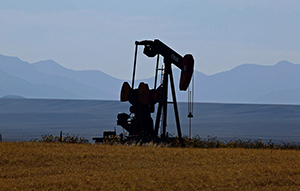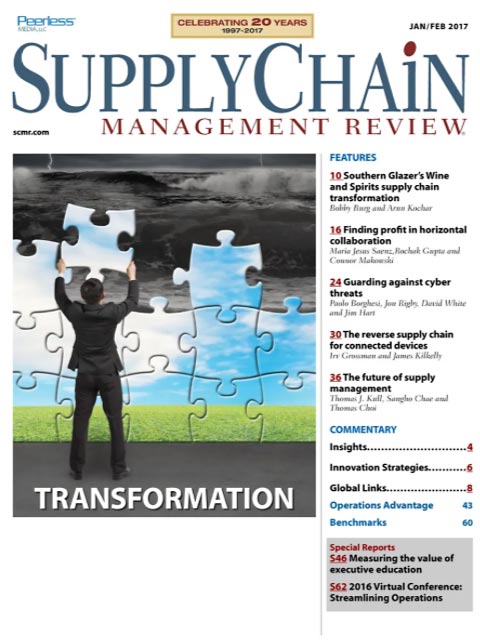Sorry, but your login has failed. Please recheck your login information and resubmit. If your subscription has expired, renew here.
January-February 2017
Transformation is a topic that comes up in almost every conversation I have with supply chain managers these days. Executives from companies as diverse as J&J Vision Care, the division of Johnson & Johnson that manufactures contact lenses, and Thrive Markets, a startup selling health and wellness products to its members, have talked about how they have had to remake their supply chains to meet new customer demands. Transformation is also the theme of this issue of SCMR. Browse this issue archive.Need Help? Contact customer service 847-559-7581 More options
This column represents my annual update on oil and the supply chain. I am dedicating it to the memory of Jay W. Forrester who passed away in November. Some managers will know who he was and what he accomplished regarding supply chain management. For others, they should think of the educational “beer game” that they have most likely played. It simulates how a lack of downstream and upstream information causes excess and volatile inventories to be held by trading partners all along a supply chain. Second, regarding oil he was the father of System Dynamics that dealt with using simulation to understand big systems, such as the impact of CO2 emissions on the global environment.
The passing of a thought leader According to Wikipedia, Forrester was a “pioneering American computer engineer and systems scientist. He was a professor at the MIT Sloan School of Management. Forrester is known as the founder of system dynamics, which deals with the simulation of interactions between objects in dynamic systems.” In 1961, “arising from a project with General Electric, he wrote about the expanding effects down the supply chains due to fluctuations in demand, thenceforth known as the ‘Forrester effect’ or bullwhip effect.” This is the effect that many of us first learned about by playing the “beer game.”
Forrester expanded his purview to urban issues and in 1969 wrote a book, “Urban Dynamics,” which sparked an ongoing debate on the feasibility of modeling broader social problems. He later met with the Club of Rome to discuss issues surrounding global sustainability and published “World Dynamics,” which “took on modeling the complex interactions of the world economy, population and ecology, which was controversial.” This book, published in 1971, along with “Limits to Growth,” which was published the following year by Club members, portended a few scary future scenarios involving limited resources to support an unlimited growth in the world’s population. Both started the field of global modeling and led to the models we read about today simulating climate changes and supporting the need to limit CO2 emissions by reducing the use of carbon-based energy. Hence, Forrester’s relevance to this oil update

This complete article is available to subscribers only.
Log in now for full access or start your PLUS+ subscription for instant access.
SC
MR
Sorry, but your login has failed. Please recheck your login information and resubmit. If your subscription has expired, renew here.
January-February 2017
Transformation is a topic that comes up in almost every conversation I have with supply chain managers these days. Executives from companies as diverse as J&J Vision Care, the division of Johnson & Johnson… Browse this issue archive. Access your online digital edition. Download a PDF file of the January-February 2017 issue.This column represents my annual update on oil and the supply chain. I am dedicating it to the memory of Jay W. Forrester who passed away in November. Some managers will know who he was and what he accomplished regarding supply chain management. For others, they should think of the educational “beer game” that they have most likely played. It simulates how a lack of downstream and upstream information causes excess and volatile inventories to be held by trading partners all along a supply chain. Second, regarding oil he was the father of System Dynamics that dealt with using simulation to understand big systems, such as the impact of CO2 emissions on the global environment.
The passing of a thought leader According to Wikipedia, Forrester was a “pioneering American computer engineer and systems scientist. He was a professor at the MIT Sloan School of Management. Forrester is known as the founder of system dynamics, which deals with the simulation of interactions between objects in dynamic systems.” In 1961, “arising from a project with General Electric, he wrote about the expanding effects down the supply chains due to fluctuations in demand, thenceforth known as the ‘Forrester effect' or bullwhip effect.” This is the effect that many of us first learned about by playing the “beer game.”
Forrester expanded his purview to urban issues and in 1969 wrote a book, “Urban Dynamics,” which sparked an ongoing debate on the feasibility of modeling broader social problems. He later met with the Club of Rome to discuss issues surrounding global sustainability and published “World Dynamics,” which “took on modeling the complex interactions of the world economy, population and ecology, which was controversial.” This book, published in 1971, along with “Limits to Growth,” which was published the following year by Club members, portended a few scary future scenarios involving limited resources to support an unlimited growth in the world's population. Both started the field of global modeling and led to the models we read about today simulating climate changes and supporting the need to limit CO2 emissions by reducing the use of carbon-based energy. Hence, Forrester's relevance to this oil update.
 SUBSCRIBERS: Click here to download PDF of the full article.
SUBSCRIBERS: Click here to download PDF of the full article.
SC
MR


Latest Supply Chain News
- Survey reveals strategies for addressing supply chain, logistics labor shortages
- Israel, Ukraine aid package to increase pressure on aerospace and defense supply chains
- How CPG brands can deliver on supplier diversity promises
- How S&OP provides the answer to in-demand products
- AI, virtual reality is bringing experiential learning into the modern age
- More News
Latest Podcast

 Explore
Explore
Latest Supply Chain News
- Survey reveals strategies for addressing supply chain, logistics labor shortages
- Israel, Ukraine aid package to increase pressure on aerospace and defense supply chains
- How CPG brands can deliver on supplier diversity promises
- How S&OP provides the answer to in-demand products
- AI, virtual reality is bringing experiential learning into the modern age
- Humanoid robots’ place in an intralogistics smart robot strategy
- More latest news
Latest Resources

Subscribe

Supply Chain Management Review delivers the best industry content.

Editors’ Picks





